

Synectics. Synectics is based on a simple concept for problem solving and creative thinking - you need to generate ideas, and you need to evaluate ideas.
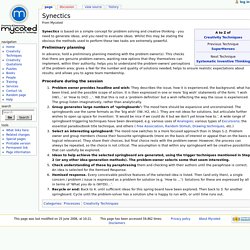
Whilst this may be stating the obvious the methods used to perform these two tasks are extremely powerful. Preliminary planning In advance, hold a preliminary planning meeting with the problem owner(s). This checks that there are genuine problem owners, wanting new options that they themselves can implement, within their authority; helps you to understand the problem-owners' perceptions of the problem area; gives a feel for the number and quality of solutions needed; helps to ensure realistic expectations about results; and allows you to agree team membership.
Procedure during the session Problem owner provides headline and wish: They describes the issue, how it is experienced, the background, what has been tried, and the possible scope of action. Critical and Creative Thinking - Bloom's Taxonomy. What are critical thinking and creative thinking?
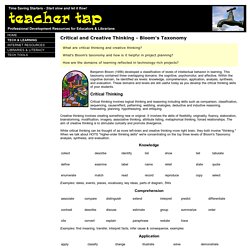
What's Bloom's taxonomy and how is it helpful in project planning? How are the domains of learning reflected in technology-rich projects? Benjamin Bloom (1956) developed a classification of levels of intellectual behavior in learning. This taxonomy contained three overlapping domains: the cognitive, psychomotor, and affective. Within the cognitive domain, he identified six levels: knowledge, comprehension, application, analysis, synthesis, and evaluation. 14 Bloom's Taxonomy Posters For Teachers.
14 Brilliant Bloom’s Taxonomy Posters For Teachers by TeachThought Staff Bloom’s Taxonomy is a useful tool for assessment design, but using it only for that function is like using a race car to go to the grocery–a huge waste of potential.
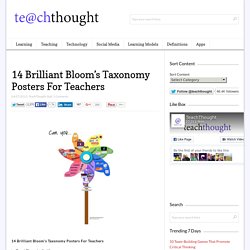
In an upcoming post we’re going to look at better use of Bloom’s taxonomy in the classroom, but during research for that post it became interesting how many variations there are of the original work. While a handful of the charts below only show aesthetic changes compared to others, most are concept maps of sorts–with graphic design that signifies extended function (power verbs), detail (clear explanations), or features of some sort (Bloom’s Taxonomy tasks by level). The follow simple, student-centered Bloom’s graphics were created by helloliteracy! Are You Tapping into Prior Knowledge Often Enough in Your Classroom? Learning progresses primarily from prior knowledge, and only secondarily from the materials we present to students, studies show.

Think about that. We teachers spend so much time gathering materials -- important and necessary for good instruction -- but are we often enough using the greatest tools right there at our fingertips? All of those young minds, ready to go! We are all guilty of hurrying through teaching some concept or skill, and not taking the time to slow down, ask the kids what they already know about the matter, and make important connections to what is to come.
I'd like to offer some research behind why we need to cut that out and activities to help us. The Research Behind It Constructivism proposes that new knowledge is constructed from old. The Swiss psychologist Jean Piaget believed educating children to be one of society's most important tasks. Use It or Lose It -- PK Strategies. _mufaro_studyguide.pdf. VTCH_A_478004_O - NONE. Post Production: Renaming Audio and Video Tracks : Multimedia 101 Podcast. ---Post Production: Renaming Audio and Video Tracks In this Post Production Quick Tip: Walter shows how taking just a few moments to rename your editing audio and video tracks in your NLE can pay big dividends for organization, collaboration, finish and revisions later in your production cycle.
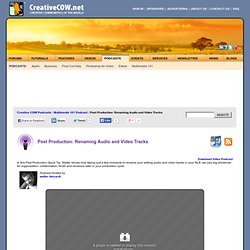
Podcast Hosted bywalter biscardi Having trouble? How to Use Digital Storytelling in Your Classroom. Empower student creativity with affordable and accessible technology.
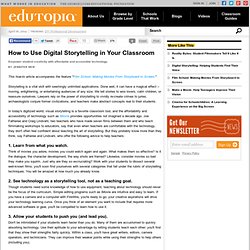
This how-to article accompanies the feature "Film School: Making Movies From Storyboard to Screen. " Storytelling is a vital skill with seemingly unlimited applications. Done well, it can have a magical effect -- moving, enlightening, or entertaining audiences of any size. We tell stories to woo lovers, calm children, or reassure ourselves. - 4.fba.11.28.pdf. The 4 Components of a DIY Professional Development Toolkit.
Education has always been a reflection of broader cultural values.
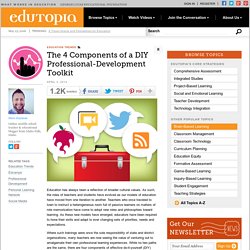
As such, the roles of teachers and students have evolved as our models of education have moved from one iteration to another. Teachers who once traveled to town to instruct a heterogeneous room full of passive learners on matters of rote memorization have come to adopt new roles and philosophies toward learning. As these new models have emerged, educators have been required to hone their skills and adapt to ever changing sets of priorities, needs and expectations. Where such trainings were once the sole responsibility of state and district organizations, many teachers are now seeing the value of venturing out to amalgamate their own professional learning experiences. While no two paths are the same, there are four components of effective do-it-yourself (DIY) professional development that all educational professionals should consider.
Twitter I finally understand how much differentiated learning matters. Blogs Edcamps. - 4.fba.11.28.pdf. What Works Clearinghouse. TPACK.ORG. CommonCoreToolkit. TPACK Lesson Plan. This is my lesson plan for my CEP 800 class.

The assignment was to create a lesson plan that used a specific technology and also applied the TPACK elements. I've included the plan below (both in text and a PDF link). Benoit Lesson Plan: Title: “Where I am From” Poem and Digital Story Technologies Integrated: Google Drive/ Slideshow Websites Teacher: Ms. Grade/Content Area: 12th grade English Lesson Overview: This lesson fits the 12th grade curriculum for poetry and self-exploration.
Materials: · Computers with Internet access (computer lab time) · Alleganps.org (Gmail based) accounts.